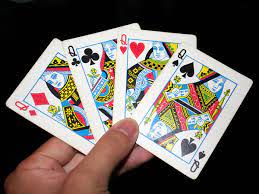Commerce is a card game that originated in France, and is played by between three and ten players. It makes use of 32; 40 or 52 cards from the Anglo-American deck, and play will unfold in a clockwise direction. It is related to the games of fan-tan and thirty-one.
It is thought that commerce is possibly related to whisky poker and bastard brag, and that it was created by a wealthy Polish family, the Brocielskis. It combines a number of games with similar game mechanics: trade and barter, the English equivalent of the game, has precisely the same combinations, but provides for a different method of getting hold of them, and trentuno, or trent-et-uno, has a very similar method of play but combinations that differ slightly.
The Object of Playing Commerce
Like the other games that fall into the commerce category, the players’ aim is to finish with the best combination of three cards in his or her hand. Players are able to better their hands by exchanging one or more cards in their hands for those on the table, and this process will continue until he or she is satisfied with the combination and starts the showdown.
The Manner in Which Commerce Play Unfolds
Although any number of players can take part in Commerce, the most usual amount is between three and ten players. A complete pack of 52 cards is used, and the cards are ranked in the following order for play: ace; king; queen; jack; ten; nine; eight; seven; six; five; four; three and two. After the dealer has been determined and game play has commenced the players will all contribute uniformly to the pool. Players are dealt three cards each, either singly or in one batch, and another set of three cards is dealt facing up to the table, forming the widow.
Without looking at the cards he or she has been dealt the dealer is allowed to exchange one or two of his or her cards for one or two of those facing up on the table, and the cards will be substituted from those in his or her hand. The dealer’s object is to make a hand, but if three cards are exchanged at once it cannot be done again at www.onlinebingocanada.net. After the dealer has finished exchanging cards the players can do likewise.
There are usually as many commerce rounds as there are players, with a fresh card being added to the widow at the start of each. A player who has managed to garner a satisfactory hand will knock on the table instead of playing, and the game draws to a close when two players have done this.
When the commerce rounds have been completed the players will reveal their cards and the one that is seen to hold the best combination will receive the stake, which was deposited in the pool. The player with the worst card combo will deposit one counter into it, an action called going up, and the player may buy another –it is termed buying a horse, and it usually costs one third the amount of the original stake, and this amount is deposited into the pool. After this has been done each player without counters must wait until the game has ended, and this process is decided by the player who manages to stay in the game for the longest amount of time, thus able to gain the final sweep.
